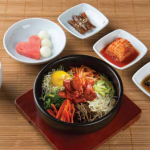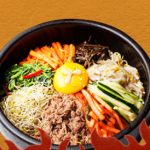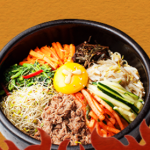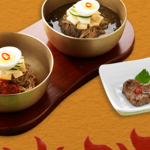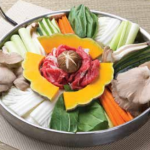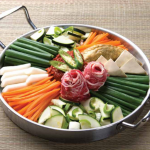Are you craving a culinary adventure? Look no further than the vibrant and diverse world of Korean cuisine. Bursting with bold flavors, unique textures, and exquisite aromas, Korean dishes are a delight to indulge in. Behind every mouthwatering creation lies a symphony of ingredients meticulously combined to create a taste sensation like no other. In this article, we will take a tantalizing journey through the key ingredients that make Korean dishes so irresistibly delicious.
Introduction: A Taste of Korea’s Culinary Treasures
Korean cuisine, known for its delightful balance of spicy, savory, sweet, and tangy, has become a global sensation. From its famous barbecued meats to its soothing stews and tantalizing side dishes, Korean dishes offer a tapestry of flavors that is both comforting and exciting.
To understand the magic behind these dishes, we must explore the fundamental ingredients that form the building blocks of Korean culinary creations. Whether you’re a seasoned Korean food enthusiast or a curious novice, join us as we unveil the secret to crafting unforgettable Korean dishes.
A Symphony of Flavors: Essential Ingredients
Korean cooking boasts a vast array of ingredients, both familiar and unique, that contribute to its distinct taste. Let’s explore some of the key ingredients that add depth, complexity, and umami to Korean cuisine:
1. Gochujang – Spicy and Sweet Red Pepper Paste
Gochujang, a staple in Korean households, is a fermented red chili pepper paste. A harmonious blend of heat, sweetness, and savory notes, this versatile ingredient serves as a foundation for many iconic Korean dishes. From the fiery heat of Bibimbap to the finger-licking goodness of Dakgalbi, gochujang adds a flavorful punch that leaves a lasting impression.
2. Doenjang – Captivating Fermented Soybean Paste
Doenjang, a traditional Korean fermented soybean paste, enriches dishes with its deep, earthy flavors. This thick paste provides depth to soups, stews, and sauces. Incorporating doenjang into iconic dishes like Doenjang Jjigae (soybean paste stew) results in a heartwarming umami experience that is sure to satisfy.
3. Sesame Oil – A Nutty Elixir
The rich and nutty aroma of sesame oil instantly transports you to the heart of Korean cuisine. Used both as a flavor enhancer and a finishing touch, this fragrant oil elevates stir-fries, marinades, dressings, and more to new heights. Just a drizzle can beautifully complement the flavors of dishes such as Japchae (stir-fried glass noodles) and Bulgogi (marinated beef).
4. Kimchi – A Fiery Fermented Delicacy
No exploration of Korean cuisine is complete without mentioning kimchi. This renowned side dish, made from fermented vegetables and spicy seasonings, adds a tantalizing kick to any meal. Whether it’s the iconic Napa cabbage kimchi or the radish variant, the complexity of flavors and the piquant aroma make it an indispensable accompaniment to Korean dishes.
5. Gochugaru – Vibrant Red Pepper Flakes
Gochugaru, or Korean red pepper flakes, brings a unique heat profile to Korean cuisine. With its smoky undertones and moderate spiciness, it provides a distinct flavor that sets Korean dishes apart. Whether it’s the iconic Tteokbokki (spicy rice cakes) or the fiery stir-fried chicken known as Dakgalbi, gochugaru adds depth and color to these delightful creations.
Conclusion: Dive into the World of Korean Cuisine
Embarking on a culinary journey through Korean cuisine promises an explosion of flavors, textures, and aromas that will leave you craving more. The key ingredients we’ve explored are just the tip of the iceberg, with countless other elements waiting to be discovered.
From the intricate balance of sweet, savory, and spicy flavors to the art of fermentation that adds complexity, Korean cuisine presents a culinary experience like no other. So next time you’re feeling adventurous, grab your apron and dive into the vibrant world of Korean cooking – a true delight for both your taste buds and your soul.
FAQs:
- What is the difference between gochujang and gochugaru?
-
While both gochujang and gochugaru are derived from red peppers, gochujang is a fermented red chili pepper paste with a spicy and sweet flavor. Gochugaru, on the other hand, refers to Korean red pepper flakes that provide a smokier heat to recipes.
-
Can I substitute gochujang with another ingredient?
-
While the unique flavor of gochujang is difficult to replicate, you can substitute it with a combination of red pepper flakes, soy sauce, sugar, and a touch of vinegar to achieve a similar taste profile.
-
How long does kimchi need to ferment?
-
The fermentation process of kimchi typically lasts anywhere from a few days to several weeks, depending on personal preference. The longer it ferments, the more complex and sour the flavors become.
-
Is Korean cuisine vegetarian-friendly?
-
While Korean cuisine does incorporate a significant amount of meat and seafood, there are several vegetarian options available. Dishes like Bibimbap, Kimchi Jjigae (kimchi stew), and Japchae can be prepared with vegetarian ingredients for a delicious meat-free experience.
-
Where can I find Korean ingredients if I don’t have access to an Asian market?
- If you don’t have access to an Asian market, you can often find Korean ingredients, such as gochujang and gochugaru, in select supermarkets or online specialty stores. Alternatively, you can try making them from scratch using readily available ingredients.
Now that you’re armed with a treasure trove of knowledge about the key ingredients in Korean cuisine, it’s time to unleash your culinary creativity in your own kitchen. Embrace the flavors, experiment fearlessly, and get ready to embark on a gastronomic adventure filled with the enchanting tastes of Korea.

